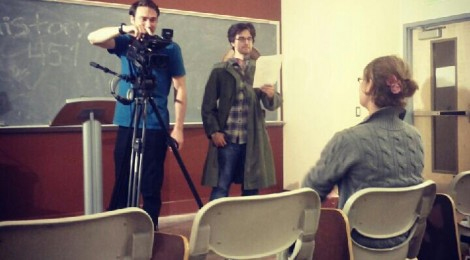
As a hungry, but not quite ravenous artist and filmmaker, I circumvent notions of decency and decadence. I ache for the presumed romantic, free-flowing lifestyle of the bohemian artiste. However, that same painful sensation is often only my need for basic dental or health care.
As the film industry in New Mexico grows, mutates or erodes, we must watch it closely to avoid the pitfalls of world cinema’s past, present and likely future. Mexico, our neighbor to the south, like many countries, has had a long and estranged relationship with tax incentives (and Hollywood). Each time a political shift caused incentives or subsidies to be pulled, it made little difference how many studios and trained personnel were left behind. There was simply no money and infrastructure to support them. Industry failed and often for decades; it has only recently recovered.
For Hollywood, this meant and still does, simply going to the next country or state that is less expensive to film in. Big industry will not do you any favors. It will not memorialize the failing production houses and studios it leaves behind.
Don’t get me wrong, tax breaks are a fantastic way to supercharge an industry, but we must take additional steps to create local infrastructure. Right now there are several states with tax incentives for film; Michigan currently offers up to a 42% tax rebate, opposed to New Mexico’s 25%. This is capitalism 101: we are battling for the most cost-effective production.
New Mexico has over one-hundred years of film history, but little significance outside of the Hollywood narrative. As filmmakers, we often think that working on a big production is the only way to make ends meet. We end up working on films that misrepresent our culture outside of a beautiful landscape or character eating Olo frozen yogurt (Breaking Bad). At least we had a New Mexican cast and story in Herbert Beberman’s Salt of the Earth. However there was also The Milagro Beanfield War: a New Mexican novel adapted to film, but performed with New York accents.
Is it possible to become as unique as our food culture? Can we reach a compromise that mirrors the red and green chile conundrum? Can we balance capitalism and art culture? Can we have our Christmas and eat it too?
There is a trend riding atop the westerly winds: dramatic increases in workshops for filmmakers, panel discussions and Q&A’s. The positive side of this is that people are being exposed to ideas and experiences previously unavailable. On the downside, there is a steady increase in the cost of such opportunities.
Don’t get me wrong, there are several recent notable events, such as the free Q&A with Breaking Bad’s Stewart Lyons. There are also many great panels at the Albuquerque Media and Film Experience. However, I have been paying close attention to many ‘locals’ who are charging two to three-hundred dollars for a short workshop. Some of whom are following the ‘if you can’t do, teach’ model, judging by their lack of credits and experience.
Now listen, I know we all need to eat, but expensive workshops are not helping your fellow Nuevo Mexicanos. We should be working together to survive, instead of scraping the insides of each other’s pockets. There is blood in the sand, but that doesn’t mean you need to be the proverbial land shark. I suggest that we instead create a solid foundation and challenge the way infrastructure meets our needs for survival.
In the tradition of Mexico and the Latin Americas, we create our own movement. We will call it, nuevo-mexicanidad, and let it represent our unique art and culture. We will join forces and make films full of slang and cultural zing! We will shout phrases at the Capitol building like “Orale, let us keep our tax rebates and create better programs you pinche bastards.” We do not have the millions that Hollywood does, but we have something more interesting, cultural capitol. Please share the wealth Mr. or Mrs. Taxperson and invest in us.
As a filmmaker, I don’t ask for a lot in life. I have a cost effective DSLR camera and a few key pieces of equipment that have not yet broken. Generally, I’m concerned with content over quality of film, and though it works for me as an artist, I cannot afford location shooting or to pay anyone a dime.
Recently, we have begun to see funding options being commercialized, such as Kickstarter, highlighted by the recent stir caused by Zach Braff and Kristen Bell raising millions of dollars apiece. No matter where you stand on this issue, it is bound to become more difficult to compete with well-run studio or celebrity campaigns to raise money through crowd sourcing. This is just another reason we need a more local approach to securing funding.
It is frustrating to live in Albuquerque, a city that wants to be different, but demands insurance for non-budgeted productions on public property. Now, let me be clear here, permits for filming are free throughout the city, assuming you do not block any streets. However, the insurance to get them is pricey.
This seems to equate for filmmakers as see no evil, hear no evil tactics. That is to say, everyone goes rogue and shoots wherever they want and without insurance. The upside is that you can use private property and not worry about either of these things (that’s something).
As a film student, I had no idea such laws existed. I knew that I was insured on campus and on private property – but the rest – no idea. I see this as a failure on the University of New Mexico’s part, as well as the cities’. I hope they will remedy this for future students and youths alike.
There might not be a perfect way to handout funding to local filmmakers, but there are several options. It could even be something as simple as taking tax revenue (free money) from big-budget films and creating very small grants for insurance for needy filmmakers. We could also create an arm of the NM Film Office to screen and setup parameters for would-be projects for funding (competition is positive). If that is too complex, we can create a volunteer unit of experienced filmmakers to culture writing talent and help develop independent projects (see Poland’s Zespoły Filmowe). Donations and state grants could easily get something like that going.
Creating simple and very small packages is the best way to start, thus protecting the state and city from liability (what they want). We are happy to put a sign up on my living-room wall that says “Santa Fe plaza” or the “Sandia Mountains,” but unless it is a comedy I’m making, no film distributor is likely to take us seriously. It is important that there is some kind of local infrastructure setup for young filmmakers and students, so they stay instead of leaving to L.A. or N.Y.C.
Let’s change the face of New Mexico film from images of the remote west and Meth cooking school teachers to something as warm and unique as the people and rich cultural heritage of our state. Let us eat Navajo Tacos on camera and recreate scenes from Jerry Zucker’s Ghost with help from La Llorona. Nuevo Mexico, you are my “Unchained Melody” and I can’t wait to capture more of you on film.
(Creative Commons feature image via Flickr by Till Krech)




Responses to “Filmmaking in New Mexico”